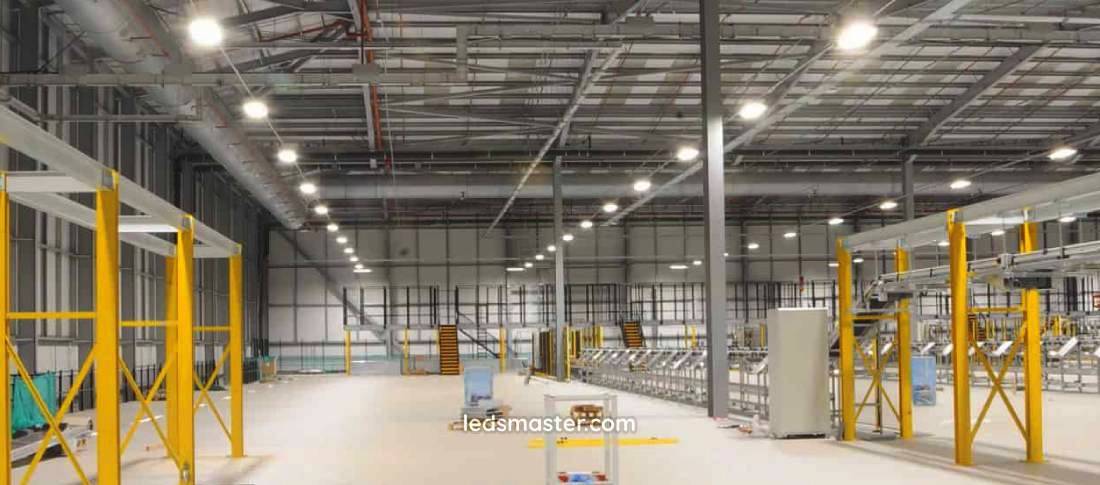Low bay lighting fixtures are specifically designed for indoor areas with lower ceiling heights, offering efficient illumination and optimal light distribution without excessive brightness. They are ideal for enhancing visibility and safety in environments like warehouses and retail spaces while minimizing energy consumption and operational costs.
Low bay lighting refers to lighting fixtures designed for spaces with lower ceiling heights, typically ranging from 12 to 20 feet. These fixtures are crucial for providing adequate illumination in areas where traditional high bay lighting would be excessive or impractical. Low bay lighting solutions offer efficient light distribution and optimal brightness levels, catering to various indoor environments such as warehouses, workshops, retail stores, and manufacturing facilities.
Get your complimentary lighting design today
Table of Contents
ToggleLow bay lighting is a specialized type of lighting fixture designed for spaces with lower ceiling heights, typically ranging from 8 to 12 feet. These fixtures are crucial for providing adequate illumination in areas like warehouses, retail environments, schools, and commercial settings. The primary objective of low bay lighting is to ensure effective light distribution without causing glare or wasting energy, making it a practical choice for various applications. This article delves into the design considerations, types of fixtures, energy efficiency, installation, maintenance, and the overall impact of low bay lighting on workplace productivity and safety.
When selecting lighting fixtures for spaces with low ceilings, compatibility becomes a major consideration. Low bay lighting fixtures are specifically engineered to operate optimally in such environments, where the mounting height is limited. Their design allows for a balanced distribution of light, ensuring that every corner of the space is adequately illuminated without creating an overwhelming amount of glare.

This compatibility helps in maintaining visual comfort while enhancing safety in work areas. With proper installation, low bay lighting minimizes light spill and shadows, which are often issues in spaces with low ceilings. Ensuring that the light is directed effectively not only improves the overall atmosphere but also contributes to the safety of the environment, making it easier for individuals to navigate the space without hazards.
Efficient light distribution is fundamental to the effectiveness of low bay lighting fixtures. These fixtures are designed to provide uniform light coverage, which is essential in minimizing shadows and dark spots that can compromise visibility. When light is evenly distributed, it enhances the overall safety of the environment, allowing individuals to perform their tasks with increased confidence and precision.
In workplaces, good lighting can facilitate productivity by ensuring that all areas are well-lit. This uniformity helps reduce the risk of accidents and enhances the ability to complete tasks efficiently. When employees can clearly see their surroundings, it reduces the likelihood of mistakes and promotes a more productive work environment.
Low bay lighting solutions are designed with energy efficiency in mind, utilizing technologies such as LED (Light Emitting Diode) or fluorescent lighting to minimize power consumption while maximizing light output. These energy-efficient fixtures not only provide adequate illumination but also contribute to lower operational costs, making them an attractive option for businesses looking to reduce their energy bills.
LED low bay fixtures, in particular, offer significant energy savings compared to traditional lighting technologies. These fixtures have a longer lifespan and require less frequent replacement, which can further contribute to cost savings over time. Energy-efficient designs align with sustainability goals, reducing carbon footprints and environmental impact, making them a sound financial investment for facility managers.
LED low bay fixtures are increasingly popular due to their energy efficiency, longevity, and superior light quality. These fixtures provide bright, uniform illumination while consuming less energy than traditional lighting technologies. LED technology also offers flexibility in color temperature, allowing users to customize lighting environments according to specific needs, such as enhancing productivity or creating a comfortable retail ambiance.
The ability to adjust color temperature is a notable feature of LED low bay fixtures. Different settings can evoke various moods or enhance certain tasks, making it easier to tailor the lighting to fit the unique requirements of each environment. This versatility is particularly beneficial in retail spaces, where lighting can influence consumer behavior and enhance the shopping experience.
Another advantage of LED fixtures is their high color rendering index (CRI), which measures the ability of a light source to accurately reproduce colors in comparison to natural light. Higher CRI values contribute to better visibility and enhance the overall aesthetic of the space. This is particularly beneficial in environments like art galleries or showrooms, where the accurate depiction of colors is essential for showcasing products.

Fluorescent low bay fixtures remain a viable option for certain applications, offering good light output and color rendering. While they typically have higher energy consumption compared to LED fixtures, they can still provide adequate lighting in various settings. These fixtures are often favored in areas where cost constraints are a primary consideration, despite their limitations.
Advances in fluorescent technology have introduced high-efficiency fluorescent lamps that provide improved energy savings and reliability. These modern fixtures are designed to be more environmentally friendly, offering better performance while reducing operational costs. Although they are not as energy-efficient as LEDs, they still serve as a practical option for many businesses.
Fluorescent lights generally have shorter lifespans than LED alternatives, leading to more frequent replacements and increased maintenance efforts. Additionally, fluorescent lamps can be sensitive to temperature fluctuations, which can impact their performance in certain environments. Businesses that choose fluorescent fixtures should be prepared for these maintenance challenges and factor them into their overall lighting strategy.
Induction lighting technology offers long lamp life and good energy efficiency, making it suitable for applications where maintenance access is limited or challenging. Induction low bay fixtures are known for their reliability and durability, making them a practical choice for industrial and commercial environments that require consistent lighting performance.
These fixtures are particularly effective in high-use areas where replacing bulbs frequently can be costly and time-consuming. The long lifespan of induction lights ensures that facilities can maintain their lighting levels without the need for regular replacements, leading to fewer disruptions in operations.
While induction fixtures may not be as popular as LED options, they still hold a valuable position in the lighting market. When comparing induction to fluorescent and LED technologies, it’s essential to consider the specific needs of the space. Induction lights tend to have higher upfront costs but can provide substantial long-term savings due to their extended lifespan and lower energy consumption.
During installation, it’s essential to follow manufacturer guidelines and recommendations to ensure the fixtures are securely mounted and aligned for optimal light distribution. Proper positioning of fixtures helps achieve uniform illumination across the floor space, enhancing visibility and reducing energy waste.
Each environment may have unique lighting requirements, and understanding these nuances is vital. For instance, warehouses may need more light in specific areas, while retail environments might benefit from adjustable fixtures that can change light intensity based on the time of day or customer flow.
Regular maintenance of low bay lighting fixtures involves cleaning lenses or diffusers to remove dust and debris that can diminish light output. Over time, accumulated dirt can significantly reduce the effectiveness of the lighting system, leading to dimmer illumination.
For LED fixtures, periodic inspection of heat sinks and electronic components is necessary to ensure efficient thermal management and prevent premature failure. Timely replacement of lamps or LED modules helps maintain consistent light levels and extends the lifespan of the fixtures, minimizing downtime and operational disruptions.
Training staff on the proper care and maintenance of lighting fixtures can contribute to their longevity. Employees should be educated about how to identify potential issues and when to report them. This proactive approach to maintenance can prevent minor problems from becoming major issues, ensuring that lighting systems remain efficient and effective.
Low bay lighting solutions, particularly those using LED technology, offer long-term cost savings through reduced energy consumption and lower maintenance costs. While the initial investment in energy-efficient fixtures may be higher, the significant operational savings over time often justify the expense, making them a financially sound choice for many businesses.
The financial advantages of low bay lighting extend beyond energy savings. Reduced maintenance needs and longer fixture lifespans contribute to a lower total cost of ownership. Facility managers can expect a solid return on investment by considering the long-term benefits of these lighting systems.
Effective illumination provided by low bay lighting enhances visibility in workplaces, reducing the risk of accidents and improving overall safety conditions. Properly lit environments enable workers to perform tasks with greater precision and confidence, contributing to productivity and operational efficiency.
When employees feel safe and comfortable in their work environment, it fosters a more positive workplace culture. Adequate lighting reduces the likelihood of accidents and injuries, which can lead to higher morale and improved overall job satisfaction.
In many industries, adequate lighting is not just a best practice; it is often a regulatory requirement. Facilities must comply with safety standards that dictate minimum lighting levels for specific areas. By implementing effective low bay lighting solutions, businesses can ensure compliance with these regulations, avoiding potential fines and legal issues.
Energy-efficient low bay lighting fixtures support environmental sustainability goals by reducing energy consumption and greenhouse gas emissions. By opting for advanced lighting technologies, businesses can actively participate in efforts to mitigate climate change and reduce their ecological footprint.
LED fixtures, in particular, have a minimal carbon footprint and contain no hazardous materials such as mercury, making them environmentally friendly alternatives to traditional lighting technologies. As more organizations prioritize sustainability, the adoption of low bay lighting can contribute to achieving corporate social responsibility objectives.
Low bay lighting fixtures play a vital role in providing efficient and effective illumination for indoor spaces with lower ceiling heights. By considering factors such as ceiling compatibility, light distribution, energy efficiency, and maintenance requirements, businesses and facility managers can select the right low bay lighting solutions to enhance visibility, safety, and operational efficiency.
With advancements in LED technology and sustainable design practices, low bay lighting continues to evolve as a preferred choice for various commercial and industrial applications. The combination of improved performance and cost savings ensures that low bay lighting remains a valuable investment for organizations looking to create safer, more productive environments.